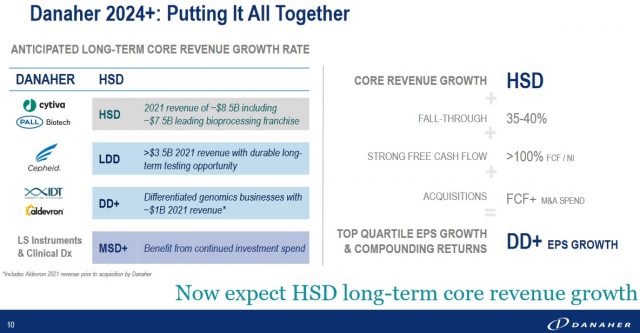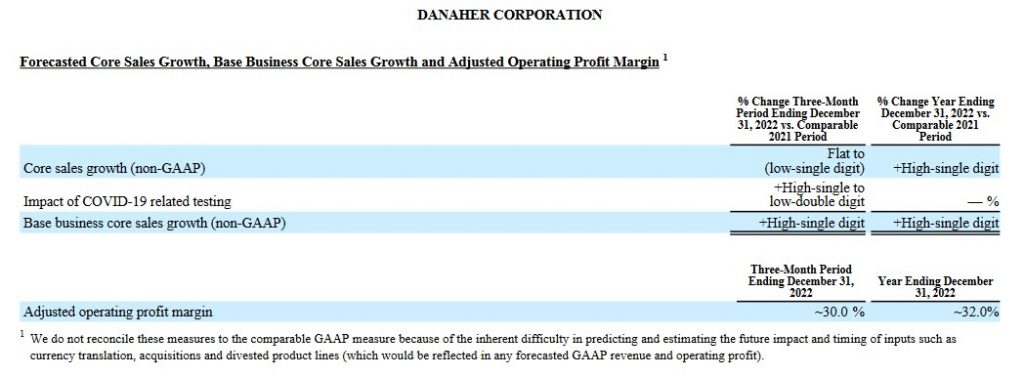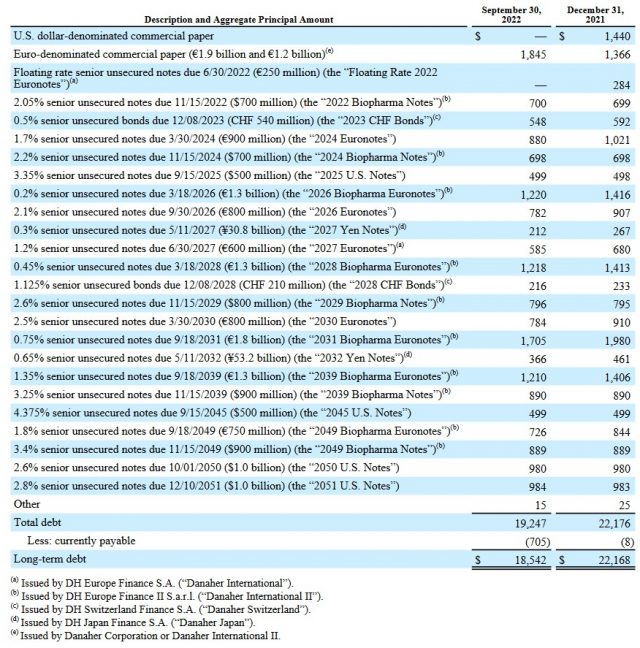Contents

In early January 2022 I initiated a Danaher (DHR) position and shared the following in my January 6 post:
Based on DHR's track record and the extent to which the Life Sciences and Diagnostics segments have grown, I would not be surprised to learn of another spin-off in the future.
Fast forward to September 14, 2022, and DHR has announced plans to separate its Environmental & Applied Solutions segment to create an independent, publicly traded company. The new company will be comprised of DHR's Water Quality and Product Identification businesses. The transaction is intended to be tax-free to DHR shareholders and is expected to be completed in Q4 2023.
I last reviewed DHR in this July 21 post at which time DHR had just released Q2 and YTD results. Now that we have Q3 and YTD results I take this opportunity to revisit it.
Overview
I have provided an overview of DHR in previous posts that are accessible through the FFJ Archives. Furthermore, any investor unfamiliar with DHR would be best served by reading Part 1 of DHR's FY2021 Annual Report and Form 10-K.
DHR Investor and Analyst Day
On September 15, DHR hosted an Investor and Analyst Day in which it showcased the Bioprocessing business and highlighted the tremendous long-term growth opportunities in biologics and genomic medicine.
DHR also announced that it is bringing together Cytiva and Pall's Life Sciences as the biotechnology group. The combined portfolio has the broadest offering in the industry with end-to-end solutions across all major therapeutic modalities for monoclonal antibodies to emerging cell, gene and mRNA-based therapies.
Proposed Environmental & Applied Solutions (EAS) Segment Spin-Off
EAS is the smallest of DHR's 3 segments having reported ~$4.7B in FY2021 Revenue and ~$3.6B in the first 3 quarters of FY2022 (versus ~$23.1B company-wide YTD2022 Revenue). In addition, EAS has only generated $0.877B of DHR's $7.564B YTD2022 Adjusted Operating Profit (non-GAAP).
It has averaged mid-single-digit core revenue growth over the last five years with ~55% recurring revenue and an adjusted EBITDA margin of ~25%.
As a stand-alone company, it will have greater opportunities to meaningfully deploy capital towards M&A.
Following this spin-off, DHR will become a more focused science and technology leader committed to innovation and making a profound impact on human health. Commencing in FY2024, DHR anticipates that ~80% of its annual revenue will be recurring.

Source: DHR - 2022 Investor and Analyst Day Presentation - September 15, 2022
Note:
- MSD: mid-single-digit
- HSD: high-single-digit
- LDD: low-double-digit
Financials
Q3 and YTD2022 Results
DHR's Q3 2022 Form 10-Q, Earnings Release, and Earnings Presentation are accessible here.
DHR reported ~$7.7B of Sales in Q3. It continues to see strong demand across the developed markets despite current macroeconomic and geopolitical events.
Q3's gross profit and operating margins were 59.8% and 26.3%, respectively. The 50 bps of core operating margin expansion was driven in part by disciplined cost management, productivity measures and price actions.
Management stated on the Q3 earnings call that the operating environment remains dynamic across DHR's businesses globally. It did, however, experience fewer supply chain disruptions in Q3 and logistics improved as freight costs began to stabilize.
Modest improvements were evident in material availability although certain electronic components remained difficult to procure.
As expected, DHR's customers continue to transition away from COVID-19 vaccine and therapeutic program and into programs for other modalities. These trends are expected to continue through Q4 resulting in high single-digit core revenue growth in the Bioprocessing business for FY2022.
Operating Cash Flow (OCF) and Free Cash Flow (FCF)
Since DHR actively acquires and divests assets, its diluted EPS is deceiving. 'Amortization of intangible assets' and 'amortization of acquisition-related inventory fair value step-up' are line items that consistently appear in the Consolidated Condensed Statements of Cash Flows. Investors should, therefore, pay particularly close attention to DHR's OCF and FCF.

Source: Reconciliation of GAAP and non-GAAP Financial Measures for Q2 and YTD 2021 and 2022 - July 21, 2022
FY2022 Outlook
In Q4, DHR expects to deliver high single-digit core revenue growth in its base business. Secondly, expectations are for a high single to low double-digit core revenue growth headwind from COVID-19 testing, resulting in core revenue growth being flat to down low single digits in the fourth quarter.
There is no change to the previous guidance of high single-digit core revenue growth in DHR's base business for FY2022.

Source: Reconciliation of GAAP and non-GAAP Financial Measures for Q3 and YTD 2021 and 2022 - October 20, 2022
Credit Ratings
We see from DHR's debt schedule at the end of Q3 2022 that debt has been raised at very attractive rates. Furthermore, maturity dates are well-balanced and go far out on the calendar.

Source: DHR - Q3 2022 Form 10-Q
DHR's credit ratings are:
- Moody's: Upgraded to A3 from Baa1 on October 10, 2022;
- S&P Global: Upgraded to A- from BBB+ on June 14, 2022.
Both ratings are at the bottom tier of the upper-medium investment-grade tier. This rating defines DHR as having a STRONG capacity to meet its financial commitments. However, DHR is somewhat more susceptible to the adverse effects of changes in circumstances and economic conditions than obligors in higher-rated categories.
These ratings satisfy my conservative investment profile.
Dividend and Dividend Yield
DHR distributes a quarterly dividend. On September 13, 2022, DHR announced that its Board approved a regular quarterly cash dividend of $0.25/share, payable on October 28, 2022 to holders of record on September 30, 2022.
At the time of my July 21 post, shares were trading at ~$278 and the $0.25 quarterly dividend yield was ~0.36%.
Shares are now trading at ~$243 and the current dividend yield is ~0.41%.
DHR is hyper-focused on capital allocation. The reason for the low dividend yield is that the Board feels superior long-term investor returns can be generated by retaining funds in the company.
Investors who rely on dividend income might immediately pass on DHR because of this low dividend yield. However, investors should not fixate on dividend metrics. The focus should be on total potential long-term investment returns.
On July 16, 2013, DHR's Board approved a repurchase program authorizing the repurchase of up to 20 million shares from time to time on the open market or in privately negotiated transactions. In the first half of FY2022, DHR did not repurchase any shares. On July 22, 2022, however, DHR repurchased 3,906 shares for $1 million as part of its Repurchase Program.
As of July 1 and September 30, 2022, ~20 million shares remained available for repurchase.
At the end of Q3 2022, DHR had Series B Mandatory Conversion Preferred Shares (MCPS) which carry an April 15, 2023 mandatory conversion date. These shares were issued to help finance the 2020 acquisition of the Biopharma business of the General Electric Company’s Life Sciences division (now names Cytiva) for a cash purchase price of ~$20.7B.
Although DHR periodically repurchases shares, the diluted average common stock and common equivalent shares outstanding (in millions) in FY2012 - FY2021 are 713, 711, 716, 709, 700, 706, 710, 726, 719 and 737. The average common stock and common equivalent shares outstanding for the 3 months ending September 30, 2022 is ~737.4 versus ~736 for the 3 months ending July 1, 2022.
As noted earlier, DHR actively acquires and divests entities. The fluctuation in the outstanding number of shares is dependent to an extent on its acquisition and divestiture activity.
Valuation
DHR's FY2012 - FY2021 diluted PE levels are 17.31, 21.56, 22.44, 25.80, 19.66, 27.63, 26.51, 45.41, 51.90, and 42.34. Trying to compare DHR's current valuation relative to its historical valuation is difficult because it has undergone a radical transformation over the last few years after having divested slower-growing businesses and acquiring several faster-growing businesses. As a result, comparing historical PE levels against current levels can lead to misleading conclusions.
At the time of my July 21 post, DHR shares were trading at ~$278. Using this share price and the current forward-adjusted diluted EPS estimates, DHR's forward-adjusted diluted PE levels were:
- FY2022 - 22 brokers - mean of $10.33 and low/high of $10.00 - $10.88. Using the mean estimate, the forward adjusted diluted PE is ~27.
- FY2023 - 21 brokers - mean of $10.87 and low/high of $10.15 - $11.50. Using the mean estimate, the forward adjusted diluted PE is ~25.7.
- FY2024 - 13 brokers - mean of $12.05 and low/high of $11.61 - $12.95. Using the mean estimate, the forward adjusted diluted PE is ~23.2.
Shares are now trading at $243. Using current forward-adjusted diluted EPS estimates, DHR's forward-adjusted diluted PE levels are:
- FY2022 - 21 brokers - mean of $10.53 and low/high of $10.34 - $10.77. Using the mean estimate, the forward adjusted diluted PE is ~23.1.
- FY2023 - 22 brokers - mean of $10.61 and low/high of $10.03 - $11.35. Using the mean estimate, the forward adjusted diluted PE is ~23.
- FY2024 - 15 brokers - mean of $11.61 and low/high of $10.85 - $13.15. Using the mean estimate, the forward adjusted diluted PE is ~21.
DHR intends to spin-off its EAS segment in Q4 2023. I am, therefore, reluctant to place much reliance on broker estimates beyond 2023.
Since the active acquisition/divestiture of businesses distorts EPS, I like to also look at DHR's Price/FCF to gauge its valuation.
DHR's FCF to net income conversion ratio has exceeded 100% for 30 consecutive years. While DHR's YTD2022 FCF from continuing operations to net earnings from continuing operations conversion ratio is only 1.04, I expect the FY2022 result to once again exceed 1.
Suppose Q4 results are relatively comparable to the first 3 quarters and the ratio remains at 1.04. Take the FY2022 $10.53 mean adjusted diluted EPS guidance from analysts. Multiply this by 1.04 and we get $10.95 FCF/share. Divide the current $243 share price by $10.95 and we get a ~22.2 P/FCF ratio. This is marginally superior to the FY2022 forward adjusted diluted PE.
Final Thoughts
I currently hold 285 DHR shares in a 'Core' account in the FFJ Portfolio. It was not, and still is not, a Top 30 holding when I completed my Mid 2022 Investment Holdings Review.
As much as I view DHR to currently be attractively valued, I envision a recession in 2023. This will very likely lead to an opportunity for investors to snap up DHR shares at even more favourable prices. However, I can not consistently correctly predict share price behaviour in the short term. I would, therefore, be slowly increasing my DHR exposure given that its credit risk is improving and its current valuation and long-term outlook are attractive. Regrettably, as explained in my recent Lockheed Martin post and Intuitive Surgical post, I am not in a position to make any significant purchases at this time.
I wish you much success on your journey to financial freedom!
Note: Please send any feedback, corrections, or questions to [email protected].
Disclosure: I am long DHR.
Disclaimer: I do not know your circumstances and do not provide individualized advice or recommendations. I encourage you to make investment decisions by conducting your research and due diligence. Consult your financial advisor about your specific situation.
I wrote this article myself and it expresses my own opinions. I do not receive compensation for it and have no business relationship with any company mentioned in this article.



